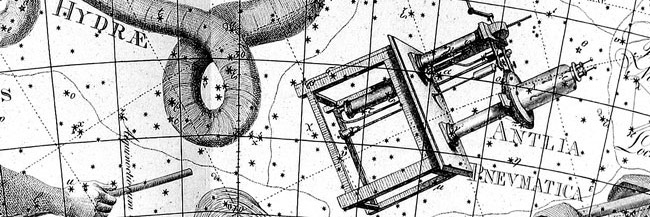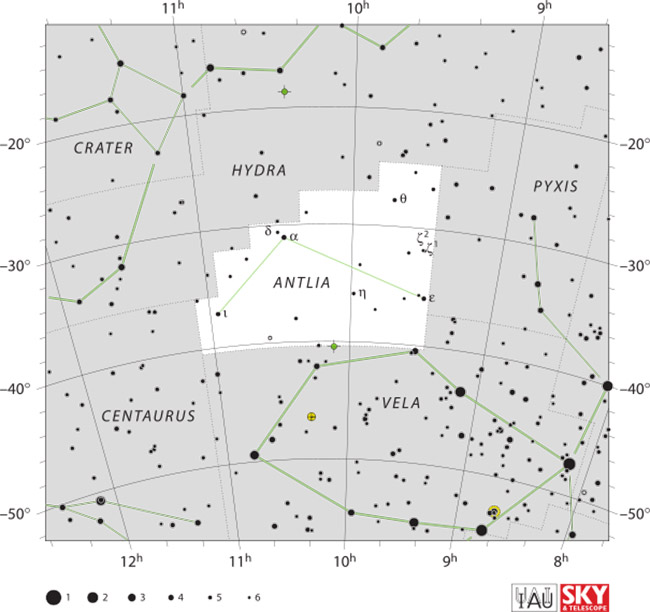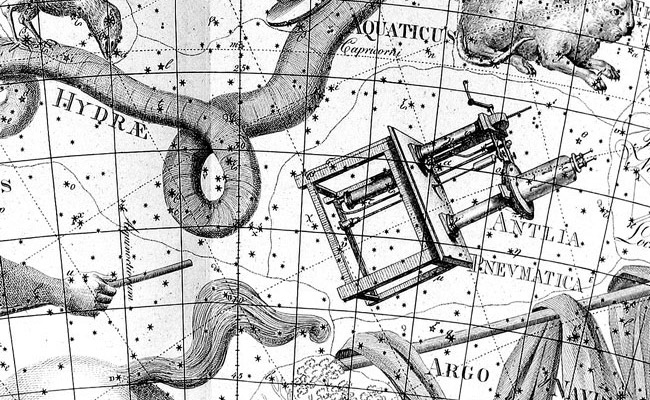Antlia – Constellation Facts

Antlia is a very small constellation and is 62nd in size. It was created and listed (along with 13 other constellations) in the 18th century by Abbé Nicolas Louis de Lacaille, who was a French astronomer. It can only be viewed in the Southern hemisphere and is located between latitudes of +45° and -90°. This fascinating grouping of stars neighbor the constellations of Centaurus, Hydra, Pyxis and Vela.
Constellation Characteristics
Antlia is 239 square degrees in size and can be found in the second quadrant of the Southern hemisphere. Antlia has only one star with known planets and does not contain any Messiers or meteor showers.

IAU and Sky & Telescope magazine (Roger Sinnott & Rick Fienberg), CC BY 3.0, via Wikimedia Commons
By IAU and Sky & Telescope magazine (Roger Sinnott & Rick Fienberg) CC BY 3.0, via Wikimedia CommonsPlanetary Systems
Although Antlia is small it does have a few deep sky objects. Check them out;
- Antlia Dwarf (PGC 29194): also referred to as the ‘Antlia Dwarf Galaxy,’ it is approximately 4.3 million light-years away and is considered a dwarf spheroidal galaxy. It is very faint in appearance and was not even discovered until 1997.
- NGC 2997 (ESO 434- G 35, PGC 27978): this unbarred spiral galaxy has well-defined arms extending from its center. It is around 24.8 million light-years away and has giant hot clouds of ionized hydrogen surrounding its nucleus.
- Antlia Cluster (Abell S0636): is a rare type of cluster called a, Bautz-Morgan type III cluster. Although it is located as close as 32 million light-years away, this cluster has not been thoroughly investigated; however, astronomers do known the Antlia Cluster is dominated by two massive elliptical galaxies; NGC 3258 and NGC 3268.
Main Stars
The constellation Antlia contains only a 8 significant stars.
- Alpha Antlia is the brightest star (which will be discussed later in detail).
- Epsilon Antliae has a magnitude of 4.51 and is a K-type giant star that is orange in color and is only 700 light-years away.
- Iota Antliae is also classified as an orange K-type giant that sits around 199 light-years in distance.
- Theta Antliae (IDS 09397-2719 B) is around 384 light-years away and is a binary star. The two parts consist of Theta Antliae A (white A-type main sequence dwarf) and Theta Antliae B ( F-type bright giant which is yellow-white).
- Eta Antliae is a binary star located 106 light-years away. The first and brightest component is a yellow-white F-type giant.
- U Antliae is considered a red C-type carbon star. It is also classified as an irregular variable star.
- AG Antliae (HD 89353) is over 2,00 light-years away and is most notable for its dust enrichment sources, which is also referred to as a post-asymptotic giant branch star.
Delta Antliae is a double star with its brighter companion being a blue-white B-type main sequence dwarf star.

The air pump shown as a complex piece of apparatus in the Uranographia of Johann Bode (1801).
The air pump shown as a complex piece of apparatus in the Uranographia of Johann Bode (1801).Most Shining Star
Out of all the stars that make up the Antlia constellation, none shine brighter than Alpha Antlia, but it is still only considered a fourth magnitude star. It is thought to be around a billion years-old and is located 365 light-years away.
Mythology & History
Although Antlia has no mythology surrounding it, it does have a some fascinating history. Named after a French physicist, Denis Papin, Antlia was named for his invention of the air pump (Antlia pneumatica). This configuration of stars represents the single-cylinder pump that Papin used in the 1670’s for his experiments.
Antlia is a fascinating constellation, so the next time you are gazing into the night sky (in the Southern hemisphere) be sure to search out this intriguing figuration of stars.
